Here's an ugly speaker I made. It's loosely based on the Linkwitz LX Mini:
LX Mini vs Bass Bin - YouTube
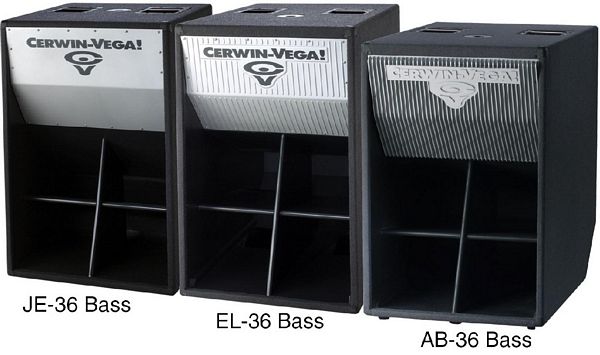
I need to draw up a diagram. It's basically a Cerwin Vega bassbin, scaled down 75%, with a $25 SB Acoustics 5". The "tweeter" is a Fostex FF85WK

Here's a rough picture of the enclosure
LX Mini vs Bass Bin - YouTube

I need to draw up a diagram. It's basically a Cerwin Vega bassbin, scaled down 75%, with a $25 SB Acoustics 5". The "tweeter" is a Fostex FF85WK

Here's a rough picture of the enclosure
Last edited:
This has got to be one of the most frustrating speakers I've ever built.
It does so many things well:
1) I can listen to it for hours
2) It's not big and ugly
My favorite aspect of it is that it's really good at extracting small details in a recording. That's one of the things that keeps me coming back to Synergy Horns, but one thing that's frustrating about Synergy horns is that they don't excite the room much. I think there's a 'sweet spot' between speakers like the Synergy Horns, which are very independent of the room, and dipole speakers, which really excite the room.
My LX Mini-ish thing falls into that sweet spot.
But UGH is it inefficient. After living with Synergy Horns and Summas and even Vandersteens, this thing is insanely power hungry. And the Fostex is only rated for fifteen watts and I'm exceeding that by a wide margin.
I'm really tempted to replace the Fostex FF85Wk with a cardioid Synergy horn. That would raise my efficency AND my output ceiling.
I listen to my music and movies LOUD and this thing can't get to where I want it to be
It does so many things well:
1) I can listen to it for hours
2) It's not big and ugly
My favorite aspect of it is that it's really good at extracting small details in a recording. That's one of the things that keeps me coming back to Synergy Horns, but one thing that's frustrating about Synergy horns is that they don't excite the room much. I think there's a 'sweet spot' between speakers like the Synergy Horns, which are very independent of the room, and dipole speakers, which really excite the room.
My LX Mini-ish thing falls into that sweet spot.
But UGH is it inefficient. After living with Synergy Horns and Summas and even Vandersteens, this thing is insanely power hungry. And the Fostex is only rated for fifteen watts and I'm exceeding that by a wide margin.
I'm really tempted to replace the Fostex FF85Wk with a cardioid Synergy horn. That would raise my efficency AND my output ceiling.
I listen to my music and movies LOUD and this thing can't get to where I want it to be
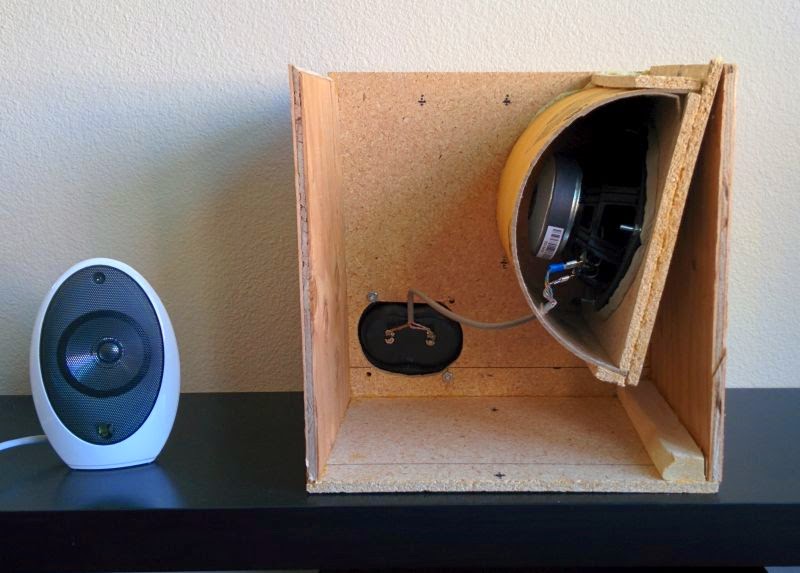
Here's a pic of the inside, before I braced it. Kef HT1000 for comparison.

The horn loaded woofer is a $20 unit from SB Acoustics that Madisound sells. Really nice, especially at this price. Good specs for horn loading.

I used a coupling chamber on the woofer to roll off the highs and increase the pathlength
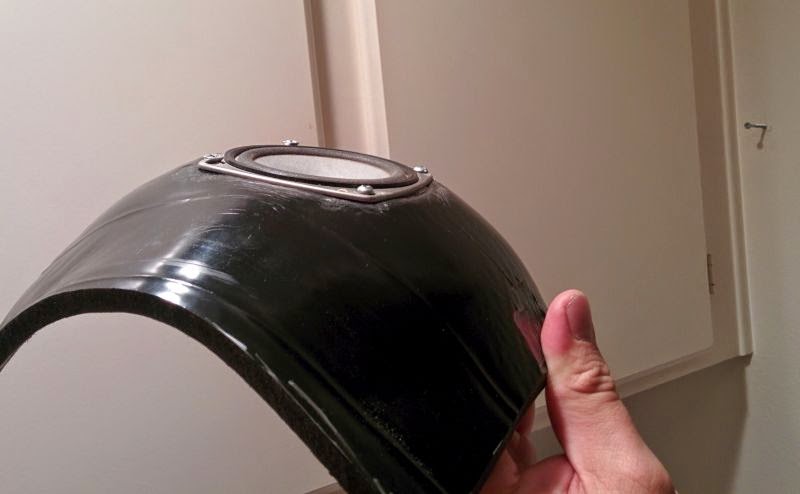
Here's a diffuser that I made out of PVC, based on the work of Dave Perrigrine. Looked neat, but it seemed to image better when set up like Linkwitz does, so I ditched it.
I built the thing and started listening, never bothered to measure it, EQ it, or build a crossover for it. One thing I've noticed from my Unity horn experiments is that you can let the horn and the coupling chamber filter out the high frequencies, which makes it possible to get away with no crossover at all if you're careful.

Here's a frequency response measurement that I made today. This is with no EQ, no crossover.
Some things I notice:
1) The horn is about 5dB "hotter" than the tweeter.
2) The tweeter doesn't play to 20khz, despite the Fostex spec sheet.
3) Although there's a broad suckout in the midrange, I have a hunch that this isn't due to the drivers themselves. I think it's mostly due to the pathlength difference between the midrange and the tweeter. The midrange is nearly a meter "behind" the tweeter, because it's buried in the horn. So I think some DSP delay could fill in the hole, basically delay the output of the tweeter so that it's in phase with the woofer.
The blue line in the picture is a Kef Model 90. I added this as a reference.

Here's a frequency response measurement that I made today. This is with no EQ, no crossover.
Some things I notice:
1) The horn is about 5dB "hotter" than the tweeter.
2) The tweeter doesn't play to 20khz, despite the Fostex spec sheet.
3) Although there's a broad suckout in the midrange, I have a hunch that this isn't due to the drivers themselves. I think it's mostly due to the pathlength difference between the midrange and the tweeter. The midrange is nearly a meter "behind" the tweeter, because it's buried in the horn. So I think some DSP delay could fill in the hole, basically delay the output of the tweeter so that it's in phase with the woofer.
The blue line in the picture is a Kef Model 90. I added this as a reference.

The red curve is the frequency response of the Ugly LX, without a crossover or EQ
The blue curve is my KEF Model 90 (for reference.)

Here's the response curves of the individual drivers. Interesting to see how low the Fostex is playing; this may be a big part of the reason that I wasn't able to get loud with this speaker. Without a highpass filter, output is unnecessarily high below the xover point. I accidentally failed to save the unequalized response of the horn, so the low frequency curve hear is equalized and crossed over. The tweeter curve here is not.

Here's the response of the horn after I applied a bandpass filter to increase power handling and improve the midrange of the loudspeaker. I also used some EQ to tame the peak at 250hz.

Here's the response of the tweeter after I applied a high pass filter to increase power handling and improve the midrange of the loudspeaker. I also used some EQ to extend the high frequency response.
Fostex spec sheets are pretty accurate, albeit on a generous scale. I have the 105WK and it looks just like the spec. I'm thinking you must have been a little bit off axis, and or your mic calibration isn't quite right in the top octave.
An externally hosted image should be here but it was not working when we last tested it.
Fostex spec sheets are pretty accurate, albeit on a generous scale. I have the 105WK and it looks just like the spec. I'm thinking you must have been a little bit off axis, and or your mic calibration isn't quite right in the top octave.
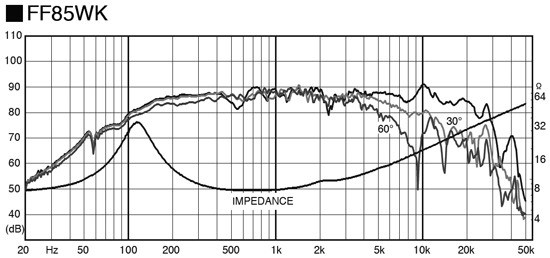
Ha! Isn't it amazing what changing the scale will do?
You are correct, the peak at 10khz is right there in the spec sheet, and so is a 10dB rolloff at 20khz. It just doesn't look so bad because the scale is so wacky.
Interesting.

Here's the response of my "Ugly LX", in red
In blue is the response of my Kefs, for reference sake
IIRC, this measurement uses no crossover whatsoever; the tweeter and the midrange are running full range.

Here's the frequency response after a little massaging with the MiniDSP.
I know that I (kinda) trashed this speaker earlier in the thread, but the MiniDSP crossover made all the difference in the world. High passing the tweeter allowed me to run a lot more power, and getting rid of the midbass hump improved the overall sound quality dramatically.
In a lot of ways this speaker reminds me of my Unity horns that I like so much. It has that articulation that I love, and the ability to extract tons of details from a recording. But the "Ugly LX" doesn't have that "giant headphone" effect that you get with horns. Due to their narrow directivity, horns have a tendency to create a soundstage that's defined sharply by the loudspeaker location. The "Ugly LX" doesn't do that; the sound seems to "float" outside the boundaries of the loudspeaker.
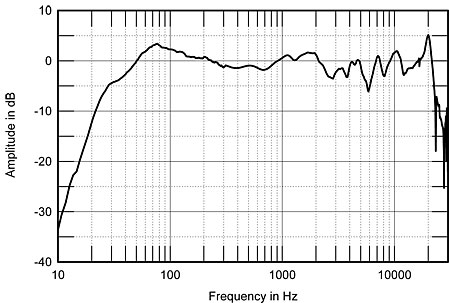
This might be a peculiar comparison, but I listened to a $60,000 stereo the other day, and in a lot of ways I prefer the "Ugly LX." True, the $60K set up could go louder, but the treble seemed "hot" and the bass exaggerated. The measurement above shows how that $60,000 set up performs. (I don't want to "name names.")

Last but not least, here's the phase response of the "Ugly LX". It's not perfect, but the phase fits within a ninety degree window over four octaves. More importantly, there's no phase rotation in the midrange, where it's really audible.
I could definitely improve the frequency response, phase response, etc.
But I think this project worked out well, so I think I may step it up a notch. You can read about THAT project here:
http://www.diyaudio.com/forums/multi-way/264680-lx-mini-homage-2nd-try.html#post4118440
Absolutely wonderful! I'm buying the Fostex!
Thanks for sharing!
I'm building a more closely reated LX-mini replica, you can check in my threads.
Best regards!
Thanks for sharing!
I'm building a more closely reated LX-mini replica, you can check in my threads.
Best regards!
I still can't figure out how you are mounting the FF85WK relative to the woofer. A good fullrange driver like the FF85WK has to be used with a high pass to relieve it from lots of excursion as it can produce bass (albeit distorted ) if asked to. This is standard FAST topology. A good full range mid/tweeter should have great frequency response and flat phase to go along - nothing new there and the attraction of FAST setups to provide great soundstage and imaging in the vocal range from 300Hz to 5kHz. What did you end up high passing your FF85WK at?
Here is an example of full range similar to the FF85WK, the Vifa TC9FD in a sealed spiral TL called the Nautaloss. This is no EQ, no XO measurement.
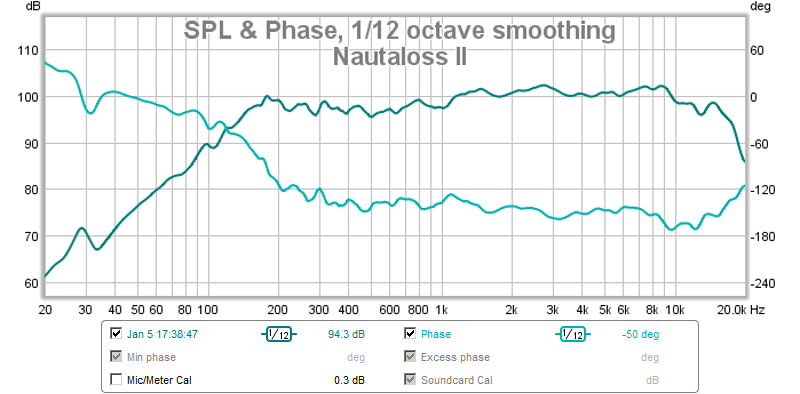
You can see it is easy to high pass it at about 200Hz and let a woofer handle duties below. This system needs very little EQ to play accurately.
Here is an example of full range similar to the FF85WK, the Vifa TC9FD in a sealed spiral TL called the Nautaloss. This is no EQ, no XO measurement.

You can see it is easy to high pass it at about 200Hz and let a woofer handle duties below. This system needs very little EQ to play accurately.
Sorry but can you explain how this is related to LXmini...two drivers is the only common feature I discern.
- Status
- Not open for further replies.
- Home
- Loudspeakers
- Multi-Way
- Ugly LX Mini "Clone"